
The New York, New Haven and Hartford Railroad, commonly known as The Consolidated, or simply as the New Haven, was a railroad that operated principally in the New England region of the United States from 1872 to 1968. Founded by the merger of the New York and New Haven and Hartford and New Haven railroads, the company had near-total dominance of railroad traffic in Southern New England for the first half of the 20th century.

The Northeast Regional is an intercity rail service operated by Amtrak in the Northeastern and Mid-Atlantic United States. In the past it has been known as the NortheastDirect, Acela Regional, or Regional. It is Amtrak's busiest route, carrying 9,163,082 passengers in fiscal year (FY) 2023. The Northeast Regional service received more than $787.7 million in gross ticket revenue in FY 2023.

A streamliner is a vehicle incorporating streamlining in a shape providing reduced air resistance. The term is applied to high-speed railway trainsets of the 1930s to 1950s, and to their successor "bullet trains". Less commonly, the term is applied to fully faired upright and recumbent bicycles. As part of the Streamline Moderne trend, the term was applied to passenger cars, trucks, and other types of light-, medium-, or heavy-duty vehicles, but now vehicle streamlining is so prevalent that it is not an outstanding characteristic. In land speed racing, it is a term applied to the long, slender, custom built, high-speed vehicles with enclosed wheels.

Illinois Central 121 was a diesel streamliner built in 1936 by Pullman-Standard and powered by Electro-Motive Corporation, which was used by the Illinois Central Railroad on the Green Diamond. Its fixed five-car consist was also the end of an era; the popularity of the early streamliners was their undoing, because the trains could not be lengthened or shortened to handle varying loads. It was the last streamliner built with the power car articulated with the train; future streamliners featured a matched but separable locomotive. The train was painted in a two-tone green livery, "Cypress Green" on the nose and below the window sills with "Cedar Green" above, separated by an aluminum strip. Extensive aluminum trim was applied.
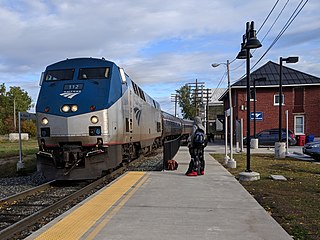
The Vermonter is a passenger train operated by Amtrak between St. Albans, Vermont, and Washington, D.C., via New York City. It replaced the overnight Montrealer, which terminated in Montreal until 1995. Amtrak receives funding from the states of Connecticut, Massachusetts, and Vermont for Vermonter operations north of New Haven.

The EMD FL9 is a model of electro-diesel locomotive, capable of operating either as a traditional diesel-electric locomotive or as an electric locomotive powered from a third rail. Sixty units were built between October 1956 and November 1960 by General Motors Electro-Motive Division for the New York, New Haven and Hartford Railroad.

The Budd Rail Diesel Car (RDC), also known as the Budd car or Buddliner, is a self-propelled diesel multiple unit (DMU) railcar. Between 1949 and 1962, 398 RDCs were built by the Budd Company of Philadelphia, Pennsylvania, United States. The cars were primarily adopted for passenger service in rural areas with low traffic density or in short-haul commuter service, and were less expensive to operate in this context than a traditional diesel locomotive-drawn train with coaches. The cars could be used singly or coupled together in train sets and controlled from the cab of the front unit. The RDC was one of the few DMU trains to achieve commercial success in North America. RDC trains were an early example of self-contained diesel multiple unit trains, an arrangement now in common use by railways all over the world.

The Pioneer Zephyr is a diesel-powered trainset built by the Budd Company in 1934 for the Chicago, Burlington & Quincy Railroad (CB&Q), commonly known as the Burlington Route. The trainset was the second internal combustion-powered streamliner built for mainline service in the United States, the first such train powered by a diesel engine, and the first to enter revenue service.

Otto August Kuhler was an American designer, one of the best known industrial designers of the American railroads. According to Trains magazine he streamstyled more locomotives and railroad cars than Cret, Dreyfuss and Loewy combined. His extensive concepts for the modernization of the American railroads have repercussions onto the railways worldwide until today. In addition he was a prolific artist of industrial aesthetics and of the American West in general.
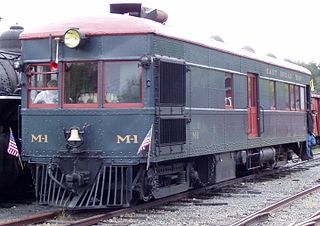
Doodlebug or hoodlebug is a nickname in the United States for a type of self-propelled railcar most commonly configured to carry both passengers and freight, often dedicated baggage, mail or express, as in a combine. The term has been used interchangeably with jitney. The name is said to have derived from the insect-like appearance of the units, as well as the slow speeds at which they would doddle or "doodle" down the tracks. Early models were usually powered by a gasoline engine, with either a mechanical drive train or a generator providing electricity to traction motors ("gas-electrics"). In later years, it was common for doodlebugs to be repowered with a diesel engine.

The UAC TurboTrain was an early high-speed, gas turbine train manufactured by United Aircraft that operated in Canada between 1968 and 1982 and in the United States between 1968 and 1976. It was one of the first gas turbine-powered trains to enter service for passenger traffic, and was also one of the first tilting trains to enter service in North America.

The railroad history of Portland, Maine, began in 1842 with the arrival of the Portland, Saco & Portsmouth Railroad (PS&P). Most of the rail activity in Portland concerned agricultural goods bound for export and European import freight. But Maine's largest city also enjoyed 125 years of continuous passenger rail service from 1842 until 1967, and has been served by Amtrak since 2001. For most of Portland's history, passenger train schedules were designed with intercity travel—to Boston, Montreal, Nova Scotia, and points west—rather than daily commuting.
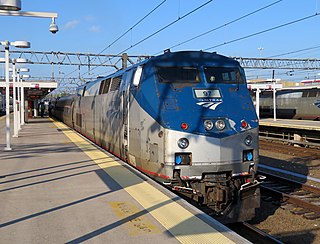
The Amtrak Hartford Line is a train service run by Amtrak primarily between Springfield, Massachusetts, and New Haven, Connecticut, along Amtrak's New Haven–Springfield Line.
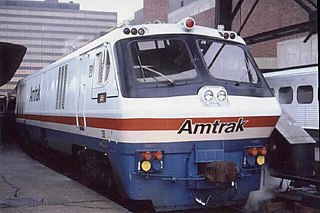
The Beacon Hill was a daily 157-mile (253 km) commuter rail service operated by Amtrak between Boston, Massachusetts, and New Haven, Connecticut, from 1978 to 1981. The Beacon Hill was one of the last long-haul commuter services operated by Amtrak. Service consisted of a single rush-hour round trip, with service eastbound to Boston in the morning and westbound to New Haven in the evening.

The Twin Cities Hiawatha, often just Hiawatha, was a named passenger train operated by the Chicago, Milwaukee, St. Paul and Pacific Railroad, and traveled from Chicago to the Twin Cities. The original train takes its name from the epic poem The Song of Hiawatha by Henry Wadsworth Longfellow. There are a number of Hiawatha-themed names within the city of Minneapolis, the terminus of the original train. The first Hiawatha ran in 1935; in 1939 the Milwaukee Road introduced a second daily trip between Chicago and Minneapolis. The two trains were known as the Morning Hiawatha and Afternoon Hiawatha, or sometimes the AM Twin Cities Hiawatha and PM Twin Cities Hiawatha. The Milwaukee Road discontinued the Afternoon Hiawatha in 1970 while the Morning Hiawatha continued running until the formation of Amtrak in 1971.
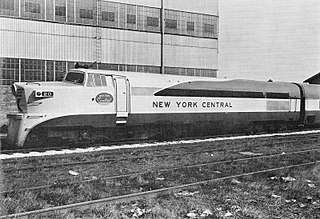
The RP-210 was a streamlined 1,000 hp (750 kW) locomotive built in 1956 by Baldwin-Lima-Hamilton, specifically to operate with the experimental, all-aluminum Train-X coaches that were built by the Pullman-Standard Car Manufacturing Company. The model represented Baldwin's attempted entry into the lightweight passenger locomotive market, but only three of the low-slung diesel-hydraulic units were produced. The first RP-210 was built for the New York Central Railroad to power their Ohio Xplorer train between Cleveland, Columbus, and Cincinnati, and a pair was purchased by the New York, New Haven and Hartford Railroad to double-end their Dan'l Webster, running between New York City and Boston.

The Roger Williams was a six-car streamlined lightweight DMU passenger train built by the Budd Company in 1956 for the New York, New Haven and Hartford Railroad. The train was based on Budd's successful RDC DMU cars. The end two cars were equipped with streamlined locomotive style cabs and noses, resembling those on the Fairbanks-Morse P-12-42 Diesel locomotives. The four intermediate cars lacked operating controls and cabs.
The John Quincy Adams was a named train of the New York, New Haven & Hartford Railroad, between New York, New York and Boston, Massachusetts. The John Quincy Adams was an attempt by the New Haven to modernize rail travel and lure people out of their cars. The train was built by American Car and Foundry to a lightweight Talgo design, and was powered by two Fairbanks-Morse P-12-42 Diesel-electric locomotives, one at each end of the train, connected by multiple unit control. It was nearly identical to the Speed Merchant operated by the Boston and Maine Railroad.
The Dan'l Webster was a trainset of the New York, New Haven and Hartford Railroad, between Grand Central Terminal, New York, New York, and South Station, Boston, Massachusetts. It only operated from 1957 to 1958.

















